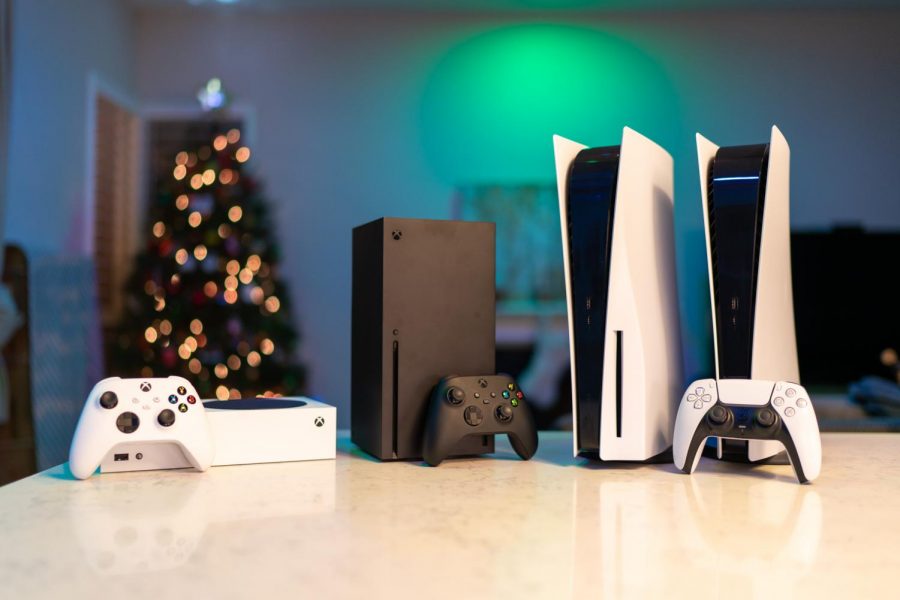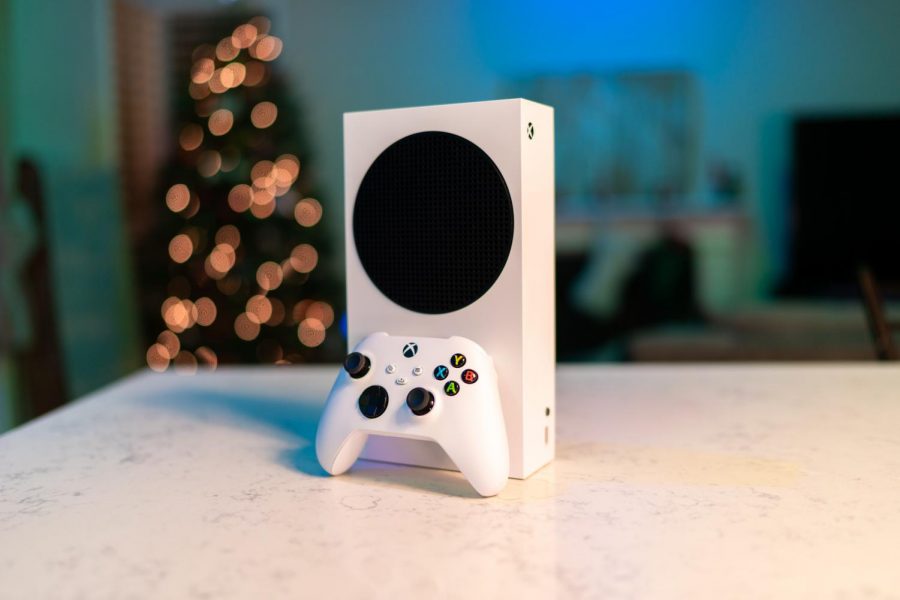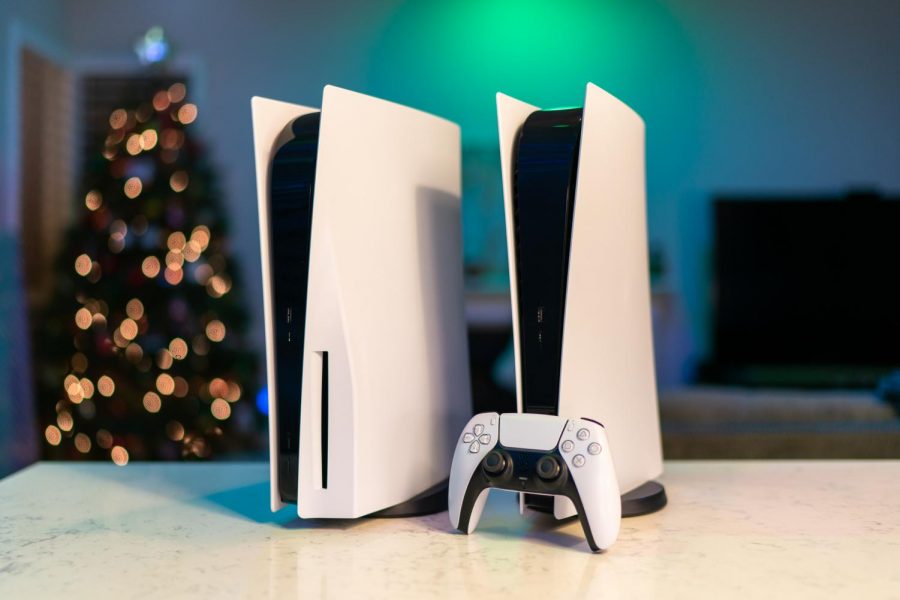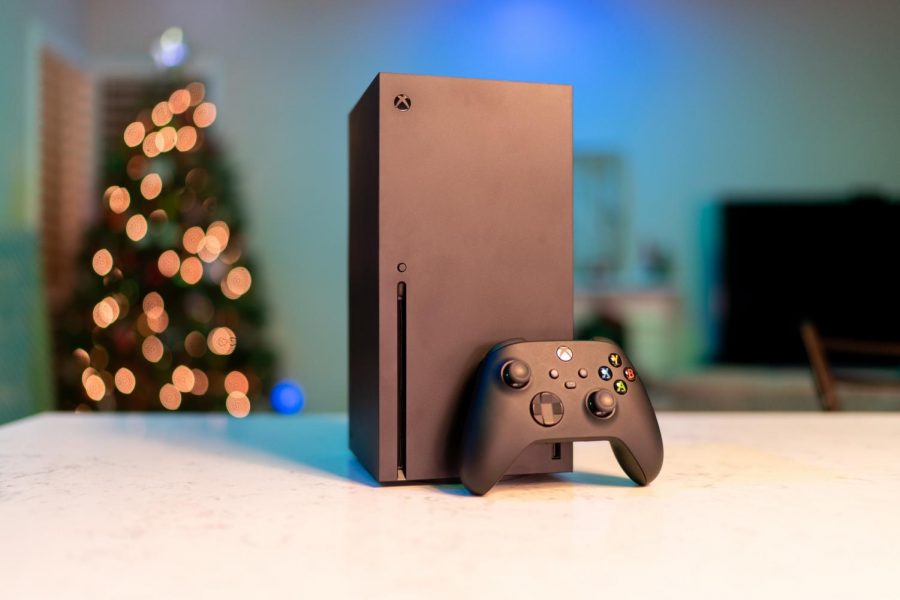PS5 vs Xbox Series X/S: Which next-gen console is right for you?
A pandemic-conscious guide to gaming this holiday season
Left to Right: The Xbox Series S, Xbox Series X, PlayStation 5, and PlayStation 5 Digital Edition have officially begun the next generation of gaming. With lighting fast loading times, ray tracing, 120 frames per second, and near silent fan speeds across all systems, these consoles are aimed at removing as many barriers from the gamer to the game.
December 24, 2020
From greedy scalpers to botched pre-orders and owners vaping into their consoles, the Playstation 5 and Xbox Series X/S couldn’t escape the controversy of 2020.
That being said, if you’re both ambitious and fortunate enough to be able to buy one of these consoles, I want to make sure that you’re spending your hard-earned money on the console that best suits your needs.
Xbox Series S: $299
It took me a while to get my hands on the Xbox Series S with scalpers flooding pre-order queues. Speaking of which, and I should not even have to say this, DO NOT PAY A SCALPER FOR A CONSOLE. If they are shady enough to charge you double for a console, they are shady enough to scam you into buying a printed picture of one. Don’t let them win.
With that out of the way, this little white box packs a next-gen punch with ray tracing, 1440p resolution targets (although it usually hits 1080p) and a lightning-fast solid-state drive for $299.
Microsoft made some compromises in order to hit that price point, though. First, the GPU performance of the Series S is technically less than that of the last-gen Xbox One X, but the GPU is more efficient with regards to computational performance, meaning games can still hit a minimum of 1080p while also delivering next-gen features such as ray tracing.
Second, it does not have a disc drive. That means you won’t be benefiting from the discounts of secondhand games, especially backwards compatible games from both Xbox 360 and the original Xbox. Instead, you’ll be limited to Xbox Store discounts and Game Pass.
Finally, and most frustratingly, you will only have 364GB of usable storage on the Series S. Modern Warfare and Warzone are both over 100 GB, so you can only download a few next-gen games until you have to pay another $219 for Microsoft’s proprietary 1TB SSD expansion — overall spending nearly $20 more than the cost of the more-powerful Series X. You could use a non-proprietary external SSD or HDD, but last-gen loading times will return.
Who is this console for, then? Well, I own one, so let me describe my own situation. I mainly play games on PC and PlayStation, but Halo hits me right in the nostalgic feels. I could purchase The Master Chief Collection and Halo Infinite on PC, but Team Slayer on Halo 5, an Xbox console exclusive, is my guilty pleasure. Since I only want to play a few games, I really don’t need an immense amount of storage. I simply need an affordable console that can play a few of my Xbox favorites, run old Xbox 360 titles and can go with me anywhere.
If my situation sounds like yours, and you plan only to play a few games on your device at a time while also saving some cash, I’d suggest picking up the Xbox Series S.
PlayStation 5: $399-$499
Now, let’s talk about the PlayStation 5. After having a rather successful previous generation with the PlayStation 4, Sony has a lot to live up to with the PS5. In many ways, they’ve delivered a new system with very new capabilities that can’t be found on either the PS4 or PS4 Pro.
Sony, like Microsoft, made two consoles for this generation, but they did it a little differently. Both versions of the console have the same exact hardware, utilizing native 4K resolutions, up to 120 frames per second and an insanely cool haptic-enabled controller called the DualSense which features adaptive triggers that can both resist and vibrate when pulled. Both consoles have 667.2GB of usable storage on their ultra-fast SSDs and ray-traced reflections and shadows (depending upon the game).
That being said, the only difference between the two PS5s is that the $399 model is an all-digital console, and the $499 model has an Ultra HD Blu-ray disc drive. Because of this, determining which console is best for you has a lot to do with whether or not you want to save your money further down the road of the console’s life-cycle.
For those who are looking for a full next-gen experience for the cheapest price possible, I would purchase the PlayStation 5 Digital Edition. You might pay a little more further down the road on digital games, but if you wait for the monthly deals on the PlayStation Store and are willing to buy AAA games several months after their release, you might save about as much as if you purchased a used game at GameStop.
If you’re not concerned with paying the extra $100, have a backlog of Ultra HD Blu-ray movies you’re trying to catch up on, and want the option of trading, buying, or collecting physical games to save money further down the road, then I would snag the standard PlayStation 5. Although, there are a few disclaimers to owning a launch PS5 that you should know about.
First, this console has several software bugs that I’ve personally experienced. From games crashing, to external hard drives frequently having to be repaired via the operating system due to the console simply turning off mid-game, the PS5 needs some software updates in order to reach the same success as the PS4. Sony has been working on patches, and these bugs only account for only a portion of my own experience, but I would take my time saving for this console if being a beta tester is an issue for you.
Secondly, both PlayStations are HUGE, and a lot of this has to do with keeping cool and quiet during gameplay, an issue PS4 owners felt heavily when playing Call of Duty Warzone. Standing at 15.4 inches tall and 10.24 inches deep, this may not fit in your current setup. Its styling is about as low-profile as its size with off-white flowing plates sandwiching a dark and glossy, navy blue panel that wraps around the perimeter of the console. If you like interpretive art pieces, this can certainly pass as one.
Finally, this console has a very lackluster approach to upgrading your older PS4 games, leaving it up to developers to re-make PS5 upgraded versions of PS4 games rather than using a method akin to Xbox’s Smart Delivery system, which allows older Xbox games to receive developer supported graphics updates rather than downloading an entirely new game. Developers may opt to update games on Xbox rather than re-make games for PlayStation, leaving PS5 players having to play many of their PS4 favorites at 1080-1800p resolution and 30-60 frames per second. A recent example of this was Call of Duty Warzone’s 120 FPS patch on Xbox Series X/S with no announcement of a patch or next-gen upgrade coming to PlayStation 5.
Xbox Series X: $499
Let’s get into the Series X’s perks first. Of all the next-gen consoles, it is technically the most powerful. PlayStation 5 boasts a 10.3 teraflop GPU, with the Series X implementing a slightly more complex 12 teraflop GPU. Series X has an 8-core, 3.8 GHz AMD Zen 2 processor compared to PlayStation 5’s slightly slower 3.5 GHz variant. As of right now, most third-party games have almost identical parity between the two systems as developers familiarize themselves with the hardware.
Besides a sleek, monolithic package to set it apart from Sony’s art project, Xbox Series X also has a significantly larger library of backwards compatible games going back to the original Xbox. Many of the Series X’s backward-compatible games run at higher frame rates and resolutions than on the original consoles they debuted on, and it’s good that they do, because something needs to make up for Microsoft’s lack of exclusive launch titles.
That being said, who is this console for? I’ve found the Series X the most difficult to identify with, as it takes on some new features such as an ultra-fast SSD, ray-tracing, and up to 120 FPS, but many of the things that the Series X can do, like playing Ultra HD Blu-ray discs, running native 4K games, and improving the graphics of older-gen games, are things that the last-gen Xbox One X can do for significantly less than the $499 that Xbox Series X demands. Because of this, I think there’s two types of gamers that may benefit from the Xbox Series X.
One is the gamer who’s new to Xbox or has an original Xbox One, might already have a PlayStation for its exclusives, and wants to take advantage of Series X’s massive backwards-compatible library and next-gen tech. The other is one who already has an Xbox One X, simply wants the newest tech, and has the bank account to afford it.
Conclusions
Not much has changed between the One X and Series X controllers, and 120 FPS is still relatively niche because few TVs and monitors currently support it. Aside from the DualSense controller, the same can be said between the PS4 Pro and PS5. Furthermore, the screens that do support these features cost about as much as a scalped Series X or PS5. Because of this, I recommend not purchasing next-gen systems unless any one of my previous descriptions deeply identify with you.
If you already have a PS4 Pro or Xbox One X, I would encourage you to do yourself a favor. Remove yourself from the stress of finding a next-gen system online, and enjoy this winter’s current-gen releases instead.
The best value right now may be with the all-digital Xbox and PlayStation, but there are too many bugs and too few next-gen exclusives to justify staying up until 12 a.m. to compete against scalper bots for an online order. By spring of next year, bugs will be patched, you’ll have more money saved, more games will be released, and scalpers will likely have to sell their consoles for market price once Sony and Microsoft manufacture more systems.
Stress less, play more and stay safe.































































































































